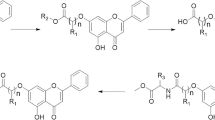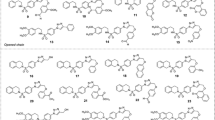Abstract
Three-dimensional quantitative structure–activity relationships were performed for a series of isatin derivatives as anti-cancer agents using the CoMFA and CoMSIA methods. Statistically significant CoMFA (\(r_{\text{cv}}^{2} = 0.869,\;r_{\text{ncv}}^{2} = 0.962\)) and CoMSIA (\(r_{\text{cv}}^{2} = 0.865,\;r_{\text{ncv}}^{2} = 0.959\)) models were generated using the training set on the basis of the common substructure-based alignment. Further, the predictive ability of the CoMFA and CoMSIA models was determined using a test set of nine compounds. Based on the information derived from CoMFA and CoMSIA contour maps, we have identified some key features for increasing the activity of compounds and have been used to design new anti-cancer agents. The newly designed molecules in this series of compounds may be more potent anti-cancer agents.





Similar content being viewed by others

References
Abadi AH, Abou-Seri SM, Abdel-Rahman DE, Klein C, Lozach O, Meijer L (2006) Synthesis of 3-substituted-2-oxoindole analogues and their evaluation as kinase inhibitors, anticancer and antiangiogenic agents. Eur J Med Chem 41:296–305
Bramson HN, Corona J, Davis ST, Dickerson SH, Edelstein M, Frye SV, Gampe RT, Harris PA, Hassell A, Holmes WD, Hunter RN, Lackey KE, Lovejoy B, Luzzio MJ, Montana V, Rocque WJ, Rusnak D, Shewchuk L, Veal JM, Walker DH, Kuyper LF (2001) Oxindole-based inhibitors of cyclin-dependent kinase 2 (CDK2): design, synthesis, enzymatic activities, and X-ray crystallographic analysis. J Med Chem 44:339–4358
Castilho MS, Postigo MP, de Paula CBV, Montanari CA, Oliva G, Andricopulo AD (2006) Two- and three-dimensional quantitative structure-activity relationships for a series of purine nucleoside phosphorylase inhibitors. Bioorg Med Chem 14:516–527
Chen N, Liu CK, Zhao LZ, Zhang HB (2012) 3D-QSAR study of multi-target-directed AchE inhibitors based on autodocking. Med Chem Res 21:245–256
Clark M, Cramer RD, Vanopdenbosch N (1989) Validation of the general-purpose tripos 5.2 force-field. J Comput Chem 10:982–1012
Cramer RD, Patterson DE, Bunce JD (1988) Comparative molecular field analysis (CoMFA). 1. Effect of shape on binding of steroids to carrier proteins. J Am Chem Soc 110:5959–5967
Gao J, Cheng YH, Cui W, Chen Q, Zhang FS, Du YG, Ji MJ (2012) 3D-QSAR and molecular docking studies of hydroxamic acids as peptide deformylase inhibitors. Med Chem Res 21:1597–1610
Gürsoy A, Karali N (2003) Synthesis and primary cytotoxicity evaluation of 3-[[(3-phenyl-4(3H)-quinazolinone-2-yl)mercaptoacetyl]hydrazono]-1H-2-indolinones. Eur J Med Chem 38:633–643
Klebe G, Abraham U, Mietzner T (1994) Molecular similarity indices in a comparative analysis (CoMSIA) of drug molecules to correlate and predict their biological activity. J Med Chem 37:4130–4146
Kubinyi H (1993) 3D QSAR in drug design: theory, methods and applications. ESCOM, Leiden
Madhavan T, Kothandan G, Gadhe CG, Cho SJ (2012) QSAR analysis on PfPK7 inhibitors using HQSAR, CoMFA, and CoMSIA. Med Chem Res 21:681–693
Matesic L, Locke JM, Bremner JB, Pyne SG, Skropeta D, Ranson M, Vine KL (2008) N-Phenethyl and N-naphthylmethyl isatins and analogues as in vitro cytotoxic agents. Bioorg Med Chem 16:3118–3124
Moon MJ, Lee SK, Lee JW, Song WK, Kim SW, Kim JI, Cho C, Choi SJ, Kim YC (2006) Synthesis and structure-activity relationships of novel indirubin derivatives as potent anti-proliferative agents with CDK2 inhibitory activities. Bioorg Med Chem 14:237–246
Pandeya SN, Smitha S, Jyoti M, Sridhar SK (2005) Biological activities of isatin and its derivatives. Acta Pharm 55:27–46
Rastija V, Medic-Saric M (2009) QSAR study of antioxidant activity of wine polyphenols. Eur J Med Chem 44:400–408
Rojo F, Albanell J, Rovira A, Corominas JM, Manzarbeitia F (2008) Targeted therapies in breast cancer. Semin Diagn Pathol 25:245–261
Sabet R, Mohammadpour M, Sadeghi A, Fassihi A (2010) QSAR study of isatin analogues as in vitro anti-cancer agents. Eur J Med Chem 45:1113–1118
Salum LD, Polikarpov I, Andricopulo AD (2007) Structural and chemical basis for enhanced affinity and potency for a large series of estrogen receptor ligands: 2D and 3D QSAR studies. J Mol Graph Model 26:434–442
Sharma VM, Prasanna P, Adi Seshu KV, Renuka B, Laxman Rao CV, Sunil Kumar G, Narasimhulu CP, Aravind Babu P, Puranik RC, Subramanyam D, Venkateswarlu A, Rajagopal S, Kumar KBS, Rao CS, Mamidi NVSR, Deevi DS, Ajaykumar R, Rajagopalan R (2002) Novel indolo[2,1-b]quinazoline analogues as cytostatic agents: synthesis, biological evaluation and structure-activity relationship. Bioorg Med Chem Lett 12:2303–2307
Singh S, Soni LK, Gupta MK, Prabhakar YS, Kaskhedikar SG (2008) QSAR studies on benzoylaminobenzoic acid derivatives as inhibitors of beta-ketoacyl-acyl carrier protein synthase III. Eur J Med Chem 43:1071–1080
Solomon VR, Hu C, Lee H (2010) Design and synthesis of anti-breast cancer agents from 4-piperazinylquinoline: a hybrid pharmacophore approach. Bioorg Med Chem 18:1563–1572
Telvekar VN, Chaudhari HK (2012) 3D-QSAR and docking-based combined in silico study on C-5 methyl substituted 4-arylthio and 4-aryloxy-3-iodopyridin-2-(1H)-one as HIV-1 RT inhibitors. Med Chem Res 21:2032–2043
Tronchet JMJ, Grigorov M, Dolatshahi N, Moriaud F, Weber J (1997) A QSAR study confirming the heterogeneity of the HEPT derivative series regarding their interaction with HIV reverse transcriptase. Eur J Med Chem 32:279–299
Verma RP, Hansch C (2010) QSAR modeling of taxane analogues against colon cancer. Eur J Med Chem 45:1470–1477
Vine KL, Locke JM, Ranson M, Pyne SG, Bremner JB (2007a) In vitro cytotoxicity evaluation of some substituted isatin derivatives. Bioorg Med Chem 15:931–938
Vine KL, Locke JM, Ranson M, Pyne SG, Bremner JB (2007b) An investigation into the cytotoxicity and mode of action of some novel N-alkyl-substituted isatins. J Med Chem 50:5109–5117
Viswanadhan VN, Ghose AK, Revankar GR, Robins RK (1989) Atomic physicochemical parameters for three dimensional structure directed quantitative structure-activity relationships. 4. Additional parameters for hydrophobic and dispersive interactions and their application for an automated superposition of certain naturally occurring nucleoside antibiotics. J Chem Inf Comp Sci 29:163–172
Wehrens R, Putter H, Buydens LMC (2000) The bootstrap: a tutorial. Chemom Intell Lab 54:35–52
Wold S (1978) Cross-validatory estimation of the number of components in factor and principal components models. Technometrics 20:397–405
Acknowledgments
The financial supports of the Research Council of the Tehran University of Medical Science, and Deputy of Research & Planning of Iran National Elite Foundation are gratefully acknowledged.
Author information
Authors and Affiliations
Corresponding author
Rights and permissions
About this article
Cite this article
Pourbasheer, E., Amanlou, M. 3D-QSAR analysis of anti-cancer agents by CoMFA and CoMSIA. Med Chem Res 23, 800–809 (2014). https://doi.org/10.1007/s00044-013-0676-3
Received:
Accepted:
Published:
Issue Date:
DOI: https://doi.org/10.1007/s00044-013-0676-3



